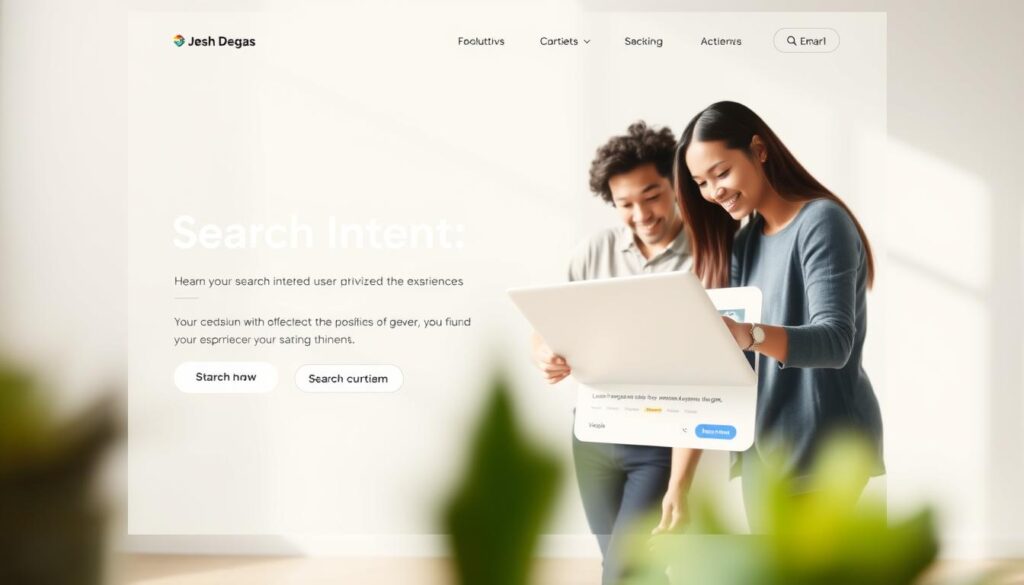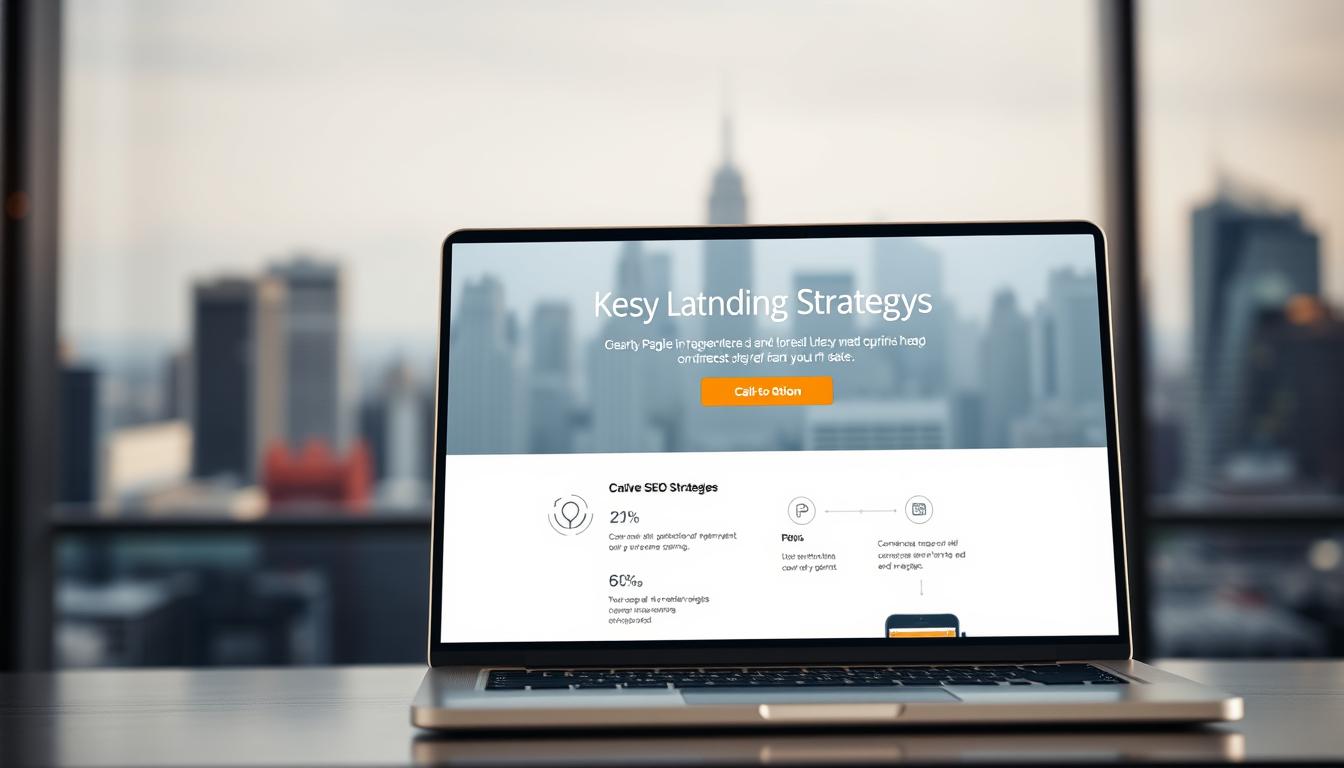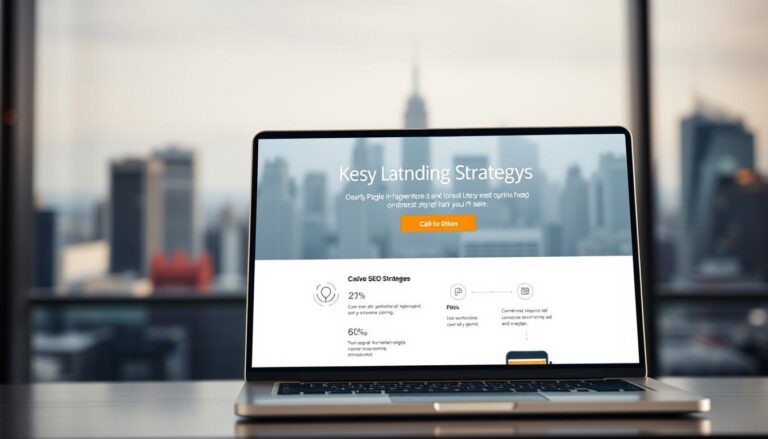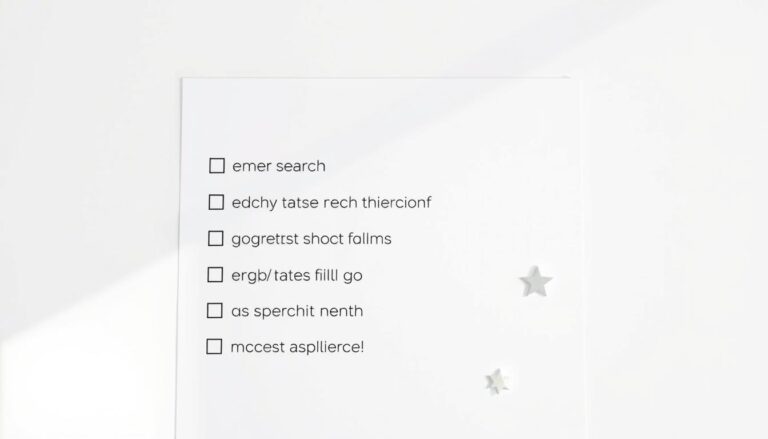This guide shows a clear way to turn a focused landing page into a scalable acquisition engine. You will learn how organic search can drive sales without ongoing ads by helping pages rank for commercial queries. Mailchimp and Salesforce prove that well-optimized content can own non-branded categories like “email automation software.”
We focus on practical steps you can run on your website today. The approach balances conversion clarity above the fold with search-friendly depth below the fold. That mix helps attract buyers ready to act and keeps the funnel efficient.
Expect a framework that covers intent mapping, keyword research, on-page elements, content strategy, mobile-first performance, internal links, backlinks, and testing. The aim is measurable results: better ranking for priority queries, higher CTR in results, longer engagement, and more completed actions.
Key Takeaways
- Well-built pages can capture commercial search demand and reduce paid spend.
- Keep conversion signals up top; add depth below to earn authority.
- Use intent mapping and targeted keywords to bring qualified traffic.
- Iterate with testing, internal links, and performance tuning.
- Real brand examples show organic rankings deliver lasting, cost-effective growth.
What “SEO for Landing Pages” Means Today and Why It Drives Conversions
A landing page persuades a user to take one clear action. It focuses on a single CTA, simple messaging, and a tight conversion path.
An SEO landing page does those things and is also built to appear in search engine results. That means aligning content to intent, using relevant keywords, and structuring information so users and engines understand the offer.
How organic visibility outlasts paid clicks
Consider a New York courier company targeting “courier services in new york city.” They can pay per click or optimize a page to rank. Ads stop delivering when the budget stops. Organic ranking can keep driving visits and conversions over time.
- Focused goal: a page should have one CTA and clear proof points.
- Intent alignment: match copy and offers to the keyword and user intent.
- Compounding value: organic listings are an acquisition asset that lowers cost per lead as rankings persist.
Expect a longer ramp than paid media, but steadier traffic, wider keyword coverage, and better click-through with strong titles and meta descriptions. Next, decide when to build a new ranking page versus optimizing an existing converter based on goals and constraints.
SEO landing pages vs SEO for landing pages: choosing the right approach for your goals
Your choice between crafting a fresh ranking asset or expanding a high-performing converter depends on goals, time, and competition. New pages aim to capture clusters of keyword intent and build steady organic traffic. Existing converters often drive immediate sign-ups and paid ROI but may miss broader search visibility.
- Create a new page when you need depth to target informational or commercial keyword clusters and to educate visitors.
- Optimize an existing converter if it already wins paid clicks or referrals but lacks organic reach.
- Consolidate only when a hero converter can gain depth without harming above-the-fold clarity.
How the two page types work together: Let an educational ranking page capture search intent and route qualified traffic to a lean conversion page. Keep the conversion URL streamlined for fast actions and use the content-rich URL to earn links, internal authority, and trust.
- Preserve above-the-fold clarity on both pages.
- Use canonical tags and consistent url strategy to avoid cannibalization.
- Coordinate messaging across paid and organic channels so visitors see a continuous value proposition.
Mapping search intent to page design and copy that visitors actually want
Map user intent to layout and copy so each visitor finds what they expect the moment the page loads.
First, classify queries as informational, commercial, or transactional. Informational pages teach and explore. Commercial pages compare and build trust. Transactional pages remove friction and push a clear CTA.

Scan current results to infer dominant intent and content types before you draft structure. Use competitor SERPs as signals, not templates.
- Informational: explainers, visuals, FAQs, light CTAs to guides or demos.
- Commercial: feature tables, competitor alternatives, social proof, soft CTAs like trials.
- Transactional: prominent CTA above the fold, benefit bullets, trust badges, minimal friction.
Intent alignment boosts relevance signals and dwell time. Good design and accessibility—clear hierarchy and scannable headers—help both people and search engines read the content.
Finally, build a module-based landing page that can flex as intent shifts across queries. Add interactive elements where they aid engagement and load fast.
Keyword research that targets buyers, not just browsers
Target buyer intent first. Build a list that favors transactional and commercial queries. These are terms people use when they plan to act, not when they are merely curious.
Finding transactional and long-tail target keywords in your niche
Begin with buyer-led research. Seek modifiers like “pricing,” “vs,” “review,” and “near me” that push intent toward conversion.
Use long-tail keywords to surface specific needs. They often face lower competition and convert better.
Balancing primary, secondary, and semantic keywords for context
Map one primary keyword to the page and layer secondary and semantic terms across headings, body copy, and image alt text.
Keep phrasing natural. Aim to explain benefits and solve a problem while using terms that clarify context.
Competitive gaps: spotting terms your rivals already rank for
Analyze SERPs to find where competitors show transactional intent but lack depth or clarity. Target those gaps with clearer content and stronger proof points.
- Validate keywords by difficulty, volume, and SERP features.
- Cluster related queries so the page addresses them cohesively.
- Document decisions so on-page work and testing align with research.
On-page optimization essentials that lift your search engine results
Small changes to titles, meta text, and media can lift clicks and clarity in search results fast.
Title tag and H1 alignment for relevance and clicks
Place the primary keyword near the start of the title tag and match its intent in the H1. That alignment signals focus to engines and helps users confirm they found the right page.
Meta description that earns the click without stuffing
Write a concise meta description that states the value and reflects user intent. Use natural phrasing so search terms appear bolded in results and boost CTR.
Clean URLs, smart internal links, and schema considerations
Keep URLs short, lowercase, and hyphen-separated with the primary keyword. Add a few internal links from relevant posts using clear anchor text, but avoid clutter near the CTA.
Implement schema for products, FAQs, or reviews to improve eligibility for enhanced engine results.
Alt text, image/file naming, and media optimization
Use descriptive file names and concise alt text that mention the target keyword naturally. Compress and resize images, pick efficient formats, and lazy-load non-critical media to protect page speed.
- Checklist: title + H1 match, meta clear, tidy URL, schema present.
- Media: descriptive names, alt text, compressed images.
- Links: a few relevant internal anchors; avoid distraction on conversion areas.
Creating content that ranks in search engines and still converts
Start by making the top of the page crystal clear: state the offer, who benefits, and the single action you want visitors to take.
Above-the-fold clarity, below-the-fold depth
Keep the hero simple. Show a concise value line, two or three benefit bullets, and a single primary CTA. Remove navigation and visual clutter that distracts the user.
Below the fold, add educational text that answers common questions and compares options. These sections attract links and help the page earn broader visibility in search engines.
Benefits over features, proof over hype: reviews, stories, and citations
Translate features into outcomes people care about. Use short benefit statements that explain how the product changes a user’s day.
Use real stories and reviews. Add customer quotes, names, and specific results when you have permission. Cite reputable third-party sources for any statistics or claims to boost credibility.
Include a small FAQ block to capture long-tail keywords and to answer objections. Scatter subtle supporting CTAs through the longer page so engaged visitors can act at any point.
- Hero: one clear CTA and benefit bullets.
- Middle: educational modules and comparisons.
- Proof: reviews, case stories, and citations.
Mobile-first experience and Core Web Vitals: the technical backbone
Mobile users now shape how a site is judged, so prioritize the phone view when you tune performance and layout.
Responsive design, tap targets, and visual stability
Search engines evaluate the mobile version of your website first. That makes the mobile layout the primary product to optimize.
Use fluid grids and scalable typography so text is readable without zoom. Keep lines short and buttons large enough to tap comfortably.
Reserve visual space for images and embeds. This prevents layout shifts and protects trust as content loads.
Speed wins: compressing assets, reducing requests, and trimming scripts
Core Web Vitals measure load time, interactivity, and layout stability. Those metrics affect both ranking and conversion rates.
- Resize and modernize images (WebP), lazy-load offscreen image assets, and serve appropriately sized media.
- Compress files, reduce HTTP requests, defer non-critical scripts, and use browser caching.
- Audit third-party scripts and remove those that don’t support core journeys or measurement.
Monitor real-user metrics and lab data after tests. Small speed gains often translate into higher engagement, more form completions, and lower abandonment.
Internal linking strategies that funnel authority and users to your page
A deliberate internal linking plan routes attention and value from popular posts straight to your conversion page. Internal links act like roads on your website: they guide visitors and help search engines understand which pages matter most.
Links from high-traffic posts, nav menus, and the homepage
Prioritize links from your highest-traffic articles, resource hubs, and the homepage when the landing page represents a core offering. Place contextual links inside related posts so the path feels natural to readers.
Anchor text that signals intent without over-optimizing
Use descriptive, varied anchor text that matches user expectation. Avoid repeating the exact phrase on every link. That keeps engines from penalizing the pattern and helps real visitors predict what they’ll find.
- Link from authoritative, high-traffic pages to boost discovery and crawl frequency.
- Add the page selectively to nav or footer only if it is evergreen or central to conversion.
- Audit links regularly to fix orphan pages and rebalance equity where needed.
Track changes: watch crawl frequency, impressions, and ranking results after new internal links. Keep the landing page lean—don’t overload it with links that distract from the main CTA.
Backlinks and promotion: earning authority the right way
Earning links begins with creating standout assets people want to cite and share. Quality backlinks act like votes of confidence that lift a page in search results. Start by producing original data, clear frameworks, or detailed guides that add real information to your niche.

Next, pair those assets with targeted outreach and social distribution. Build a list of journalists, bloggers, and partners who cover the topic. Personalize each pitch and explain why your resource benefits their audience.
- Make content worth citing: reports, infographics, and practical how-tos tied to the landing page topic.
- Personalize outreach with a clear hook and one-line value for the recipient.
- Use social channels to seed visibility and spark natural link growth.
- Keep time-bound pages live or 301-redirect them to retain earned authority.
Not all links carry equal weight. Prioritize coverage from reputable, relevant websites and avoid manipulative tactics. Track referring domains, anchor diversity, and the lift in organic traffic and assisted conversions to tie backlinks back to business results.
Present-day performance tracking and iteration for maximum ROI
Measure how visitors find and interact with the page to spot quick wins and long-term trends. Capture discovery signals like rankings, impressions, and queries to understand how search results surface your content.
Pair those acquisition metrics with onsite behavior. Look at engagement, scroll depth, and conversions to find friction points. Track Core Web Vitals and page performance to spot fixes: compress images, reduce requests, and remove unnecessary redirects.
Monitoring rankings, queries, and onsite behavior
Regularly review which keywords drive impressions and clicks. Use that input to refine titles, meta text, and module content so the page matches actual visitor intent.
A/B testing headlines, images, and CTAs without hurting SEO
Run server-side or SEO-friendly tests to avoid cloaking. Keep canonical URLs and avoid heavy client-side scripts that harm Core Web Vitals.
Keeping evergreen and seasonal landing pages live with smart redirects
Keep evergreen and seasonal pages live to retain authority. If retiring a page, 301-redirect to the most relevant current page and explain the change to visitors.
- Quick wins: add internal links and promote the page like a blog post to boost initial traffic.
- Long-term: document tests and tie visits to revenue so iterations prioritize ROI.
seo for landing pages that rank and convert: your next steps
Move from research to steady gains by mapping intent, building a focused keyword cluster, and designing a single, obvious action on each landing page.
Execute on-page fundamentals: clear titles and H1s, concise meta text, tidy URLs, helpful internal links, and accessible media. Optimize the mobile view and Core Web Vitals so technical issues don’t undercut conversions.
Route high-traffic posts to this page and create assets that earn quality backlinks. Launch, promote, and monitor results; then A/B test headlines, images, and CTAs while preserving search engine signals.
Commit to a review cadence: update content, expand the cluster, and measure positions, CTR, engagement, and conversions. Small, consistent improvements compound into lasting traffic and better business outcomes.










